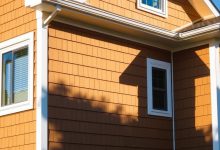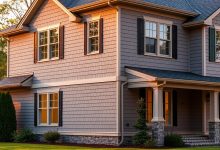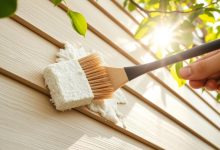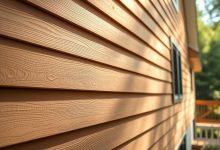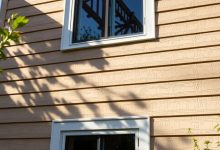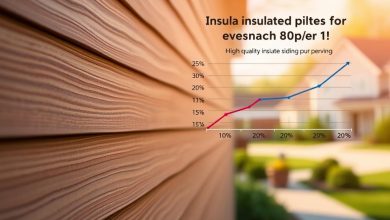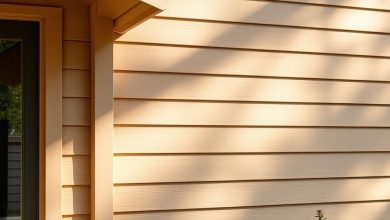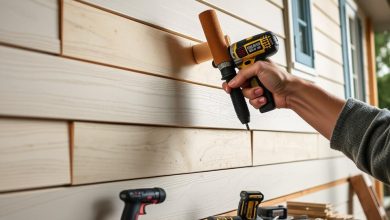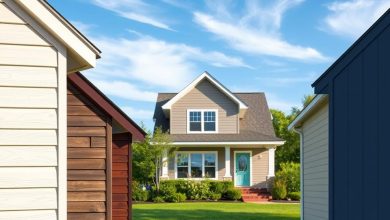Vinyl Insulated Siding: Protect Your Home in Style
Homeowners are always looking to make their homes better. They want them to be both functional and good-looking. Installing vinyl insulated siding is a smart choice. It boosts your home’s energy efficiency and looks.
Choosing the right siding can keep your home safe from the weather. It also makes your home look better. Plus, it helps save energy, which can cut down your bills and help the planet.
Key Takeaways
- Enhance your home’s energy efficiency with vinyl insulated siding
- Improve your home’s curb appeal and style
- Protect your home from the elements
- Potential cost savings on energy bills
- Contribute to a reduced carbon footprint
Understanding Vinyl Insulated Siding
Vinyl insulated siding combines the best of vinyl siding with insulation. It offers a strong exterior and boosts energy efficiency.
This siding solution gives your home a beautiful look. It also makes it more energy-efficient.
The Structure and Components
Vinyl insulated siding has two main parts: the vinyl exterior and the insulation backing.
The vinyl exterior is top-notch. It can handle all kinds of weather.
How It Differs from Traditional Vinyl Siding
Vinyl insulated siding has something traditional vinyl doesn’t: insulation.
This extra layer makes your home more energy-efficient. It also lasts longer.
Insulation Backing Technology
The insulation backing technology seals your home tight against the weather.
This tech stops heat from moving between inside and outside your home.
Thickness and Material Composition
The thickness and materials of vinyl insulated siding vary by manufacturer.
Usually, it’s a mix of vinyl and foam insulation.
| Component | Description | Benefits |
|---|---|---|
| Exterior Vinyl Layer | Made from high-quality vinyl | Durable, weather-resistant |
| Insulation Backing | Rigid foam insulation | Improved energy efficiency, reduced heat transfer |
| Overall | Combination of vinyl and insulation | Enhanced durability, improved energy efficiency |
The Benefits of Vinyl Insulated Siding for Your Home
Installing vinyl insulated siding brings many benefits to homeowners. It boosts energy efficiency and durability. This siding combines several advantages, making homes more efficient and attractive.
Energy Efficiency Advantages
Vinyl insulated siding helps homes use less energy. It adds insulation, cutting down on heat loss in winter and heat gain in summer. This leads to lower energy bills and a cozier home.
Noise Reduction Properties
This siding also reduces noise. Its extra insulation blocks outside sounds, making homes quieter and more peaceful.
Durability and Weather Resistance
Vinyl insulated siding is durable and weather-resistant. It can handle heavy rain, hail, and strong sunlight.
Impact Resistance
It’s also impact-resistant, perfect for areas with harsh weather. It can take hits without damage, saving money over time.
Protection Against Extreme Temperatures
Lastly, it protects against extreme temperatures. This keeps the indoor climate stable, easing the load on heating and cooling systems.
Enhancing Your Home’s Curb Appeal with Vinyl Insulated Siding
Vinyl insulated siding is a great choice for your home’s exterior. It combines style and function. This siding gives your home a fresh look and boosts its appeal.
Available Styles and Designs
Vinyl insulated siding comes in many styles and designs. You can pick from:
- Traditional lap siding for a classic look
- Decorative and specialty profiles for a more unique appearance
Traditional Lap Siding Options
Traditional lap siding is a timeless choice. It fits well with many home styles. You can choose different widths and patterns to get the look you want.
Decorative and Specialty Profiles
If you want something different, decorative and specialty profiles are great. They include shake, shingle, and board-and-batten styles. These can make your home’s exterior stand out.

Color Options and Finishes
Vinyl insulated siding comes in a wide range of color options and finishes. Homeowners can find the perfect match for their home’s color scheme and style. You can choose from earth tones to bold colors.
Architectural Compatibility
Vinyl insulated siding is known for its architectural compatibility. It works well with many home styles, from modern to traditional. This enhances your home’s curb appeal without changing its character.
Energy Savings: How Vinyl Insulated Siding Reduces Utility Bills
Vinyl insulated siding is more than a cosmetic upgrade. It helps cut down on energy waste. Homeowners can see a big improvement in their home’s energy efficiency thanks to the insulation in the siding.
R-Value Explained
The R-value shows how well siding stops heat flow. A higher R-value means better insulation. Vinyl insulated siding usually has a higher R-value than regular vinyl siding, making it more energy-efficient.
Seasonal Energy Performance
Vinyl insulated siding works well in all seasons, providing benefits all year.
Winter Heat Retention
In winter, it keeps the heat inside, cutting down on heating needs. This saves energy and lowers utility bills.
Summer Cooling Benefits
In summer, it blocks outside heat, keeping the home cooler. This means less work for cooling systems, saving more energy.
Long-Term Cost Benefits
The energy savings from vinyl insulated siding add up over time. The upfront cost may be higher, but the savings on utility bills can be significant.
| Season | Energy Savings | Utility Bill Reduction |
|---|---|---|
| Winter | Improved heat retention | 10-15% |
| Summer | Enhanced cooling | 12-18% |
| Annual | Total energy savings | 15-20% |
Knowing about R-value and seasonal performance helps homeowners choose the right siding. This leads to a more energy-efficient home and lower utility bills.
Types of Vinyl Insulated Siding Available Today
Homeowners have many choices when it comes to vinyl insulated siding. Each type has its own benefits and features. This variety helps homeowners find the perfect siding for their homes, matching their needs and budgets.
Contoured vs. Flat-Back Insulated Siding
Vinyl insulated siding comes in two main types: contoured and flat-back. Contoured siding looks like traditional siding, with a textured surface. It gives a classic look. Flat-back insulated siding, on the other hand, has a smoother look. It’s great for those who want a modern appearance.
Premium vs. Standard Options
The market has both premium and standard vinyl insulated siding. Premium siding is more durable, comes in more colors, and may have extra features. Standard options are cheaper but offer the basic benefits of vinyl insulated siding.
Specialized Insulated Siding Products
For those with specific needs, there are specialized insulated siding products. These include:
-
Hurricane-Resistant Options
are made to handle extreme weather. They add extra protection for homes in storm-prone areas.
-
Extra-Thick Insulation Varieties
improve energy efficiency and reduce noise.
These specialized products show how versatile vinyl insulated siding is. It’s a good choice for many homeowners.
Comparing Vinyl Insulated Siding to Other Siding Options
Your home’s exterior fights off the elements. So, it’s key to compare vinyl insulated siding with other siding types. This helps find the best match for your home.
Vinyl Insulated vs. Traditional Vinyl
Vinyl insulated siding beats traditional vinyl in energy efficiency. It keeps your home warmer in winter and cooler in summer. This means lower bills for heating and cooling.
Traditional vinyl is durable and easy to care for. But, vinyl insulated siding is even more durable. It also looks more premium because it’s thicker and stronger.
Vinyl Insulated vs. Fiber Cement
Fiber cement siding is tough and resists pests and fire. But, it’s not as energy-efficient as vinyl insulated siding. Vinyl insulated siding has a higher R-value, which saves money on bills.
Fiber cement siding looks more like real wood, which some people like. But, it needs more upkeep. It must be repainted over time.
Vinyl Insulated vs. Wood Siding
Wood siding is classic and natural. But, it needs regular painting or staining. It’s also vulnerable to pests and weather damage.
Vinyl insulated siding is more durable and low-maintenance. It looks like wood but doesn’t need constant upkeep. Plus, it’s less likely to crack or split.
Vinyl Insulated vs. Aluminum Siding
Aluminum siding is durable and pest-resistant. But, it can dent easily. It also doesn’t save as much energy as vinyl insulated siding.
Vinyl insulated siding is a better choice. It’s durable and energy-efficient. While aluminum might cost less at first, vinyl insulated siding saves money in the long run.
Installation Process for Vinyl Insulated Siding
Installing vinyl insulated siding requires a careful plan. This method boosts your home’s look and energy efficiency.
Preparation Requirements
Several steps are key before starting. These steps ensure the siding is installed right and works well.
Home Assessment and Measurements
First, check your home’s exterior. This helps figure out the right siding size. Also, look for any damage or rot that needs fixing.
Removing Existing Siding
Removing old siding is a big step. It can be hard work. You might need a pro, depending on the siding’s condition and layers.
Professional vs. DIY Installation
Deciding between a pro or DIY is important. DIY saves money but needs time, skill, and the right tools.
| Installation Method | Cost | Time Required | Skill Level |
|---|---|---|---|
| Professional Installation | Higher upfront cost | Less time-consuming for homeowners | Expertise provided by professionals |
| DIY Installation | Lower upfront cost | More time-consuming for homeowners | Requires significant DIY skills |
Timeline and What to Expect
The siding installation time varies. It depends on your home’s size, the job’s complexity, and if you hire pros or DIY. Pros usually take a few days to a couple of weeks.
Knowing the installation steps helps you get ready. Whether you hire pros or DIY, being prepared is essential for a good job.
Cost Analysis of Vinyl Insulated Siding
Homeowners thinking about vinyl insulated siding need to do a cost analysis. This includes looking at both short-term and long-term costs.
Initial Investment Considerations
The upfront cost of vinyl insulated siding might be higher than other options. But, think about the long-term benefits and energy savings. The price depends on your home’s size, installation complexity, and the siding type.
Long-Term Value and ROI
Vinyl insulated siding is a smart investment because it lasts long and saves on energy. You’ll likely get back most of what you spent when you sell your home.
Financing Options and Incentives
There are many financing options and incentives for vinyl insulated siding. These include:
- Tax credits and rebates for energy-efficient upgrades
- Manufacturer financing programs with good rates and terms
Tax Credits and Rebates
Homeowners might get tax credits and rebates to lower the initial cost. These vary by location and change, so check current offers.
Manufacturer Financing Programs
Some makers offer financing to make vinyl insulated siding easier to get. These programs offer attractive financing options with little to no down payment.
| Financing Option | Benefits | Typical Terms |
|---|---|---|
| Tax Credits | Reduces taxable income | Varies by year and location |
| Manufacturer Financing | Competitive rates, flexible terms | 5-15 years |
| Rebates | Direct reduction in cost | Limited by program funds |
Maintenance Tips for Vinyl Insulated Siding
To keep your vinyl insulated siding in top shape, regular care is key. Keeping it clean and well-maintained helps it look good and work well. It also protects your home from the weather.
Routine Cleaning Procedures
It’s important to clean your siding often to get rid of dirt and mildew. Use a soft brush or a low-pressure washer with mild soap. Don’t use strong water pressure or harsh cleaners that can harm the siding.
- Mix 1 cup of household bleach with 1 gallon of water for a cleaning solution.
- Rinse the siding thoroughly with clean water after cleaning.
- For tougher stains, consider using a cleaning product designed for vinyl siding.
Addressing Damage and Repairs
Check your siding often for damage like cracks or loose panels. Fixing these problems quickly helps keep your siding in good shape.
- For minor damages, use a vinyl siding repair kit to fix the issue.
- If a panel is severely damaged, consider replacing it entirely.
- Ensure all panels are securely fastened to prevent wind damage.
Seasonal Maintenance Checklist
Seasonal checks can help spot problems early. Here’s a simple guide:
- Spring: Inspect for winter damage and clean the siding.
- Summer: Check for signs of warping or buckling due to heat.
- Fall: Clear leaves and debris from the siding and gutters.
- Winter: Ensure that snow and ice are not accumulating behind or under the siding.

Environmental Impact of Choosing Vinyl Insulated Siding
Vinyl insulated siding has many environmental effects. It involves sustainability, saving energy, and what happens when it’s no longer needed. It’s important for homeowners to know how it affects the planet.
Sustainability Factors
Vinyl insulated siding is made from PVC. This has raised questions about its making and if it can be recycled. But, new ways to make it are more eco-friendly. Some products even use recycled materials.
Energy Conservation Benefits
Vinyl insulated siding helps save energy. It adds an extra layer of insulation. This means less heat lost in winter and less heat gained in summer. So, it uses less energy overall.
End-of-Life Considerations
When vinyl insulated siding reaches the end of its life, it can end up in landfills. But, some makers are working on recycling programs. This could help reduce waste.
Experts say, “To lessen vinyl siding’s environmental impact, we need better making, energy-saving design, and new ways to deal with it when it’s done.”
“The key to minimizing the environmental impact of vinyl insulated siding lies in responsible manufacturing practices, energy-efficient design, and innovative end-of-life solutions.”
Conclusion: Is Vinyl Insulated Siding Right for Your Home?
Vinyl insulated siding brings many benefits to homeowners. It boosts curb appeal and cuts down on energy costs. Its design also stands up well against different weather conditions, making it a strong choice.
Thinking about home improvement decisions means looking at the good and bad sides. Vinyl siding is great because it saves energy, reduces noise, and is easy to care for. But, you should think about what you really need.
The vinyl insulated siding benefits go beyond just looks. It’s a smart choice that can also raise your home’s value. When deciding on home improvement, see if vinyl siding fits your goals. Maybe you want to save on energy or make your home look better.
In short, vinyl insulated siding is a good choice for many homeowners. Knowing its benefits and what you need can help you make the right choice for your home.

